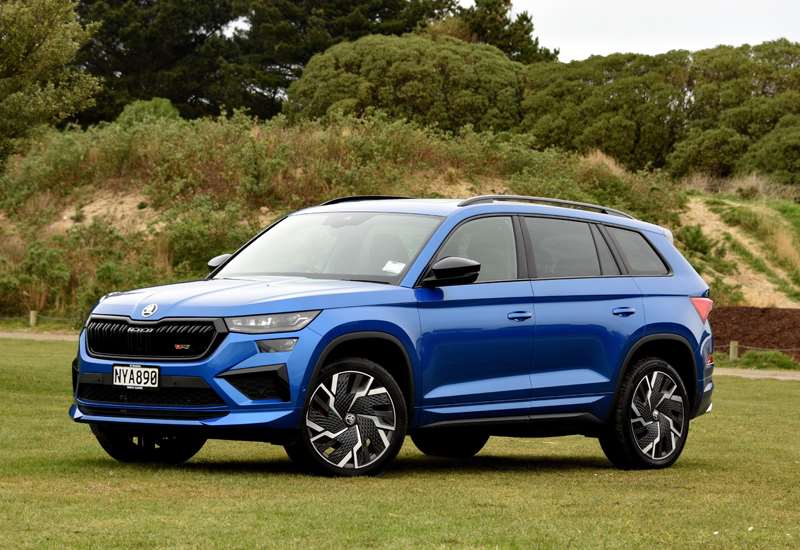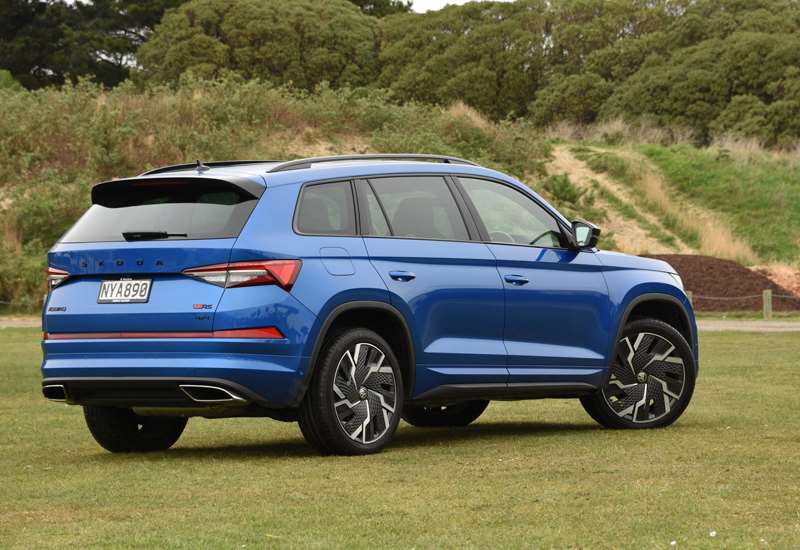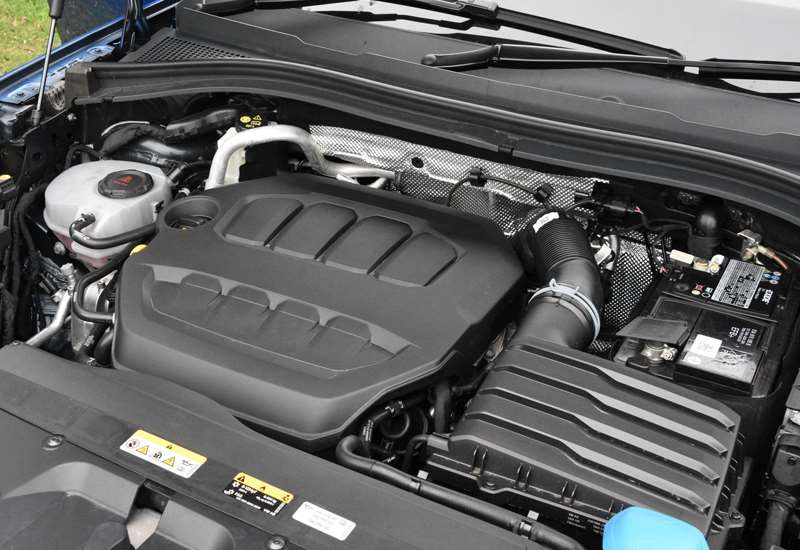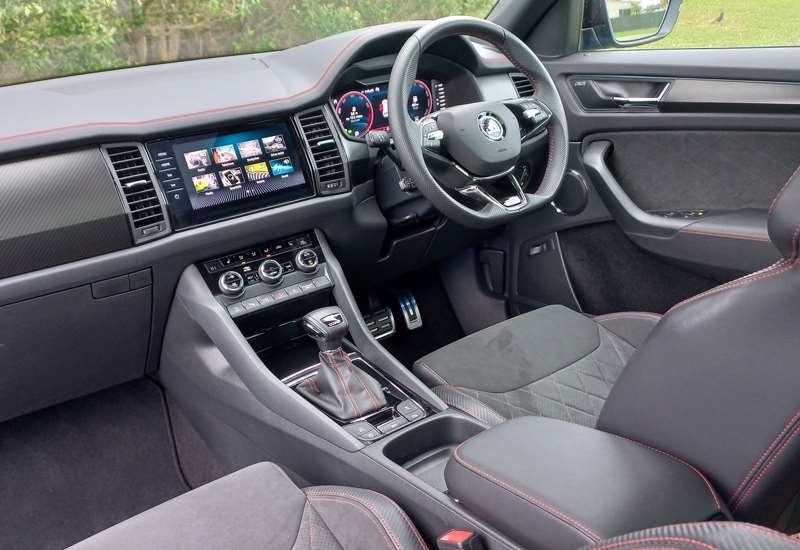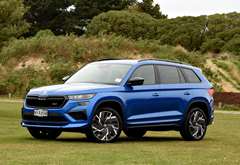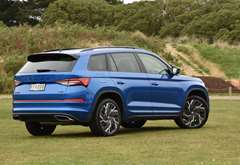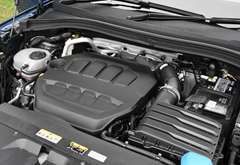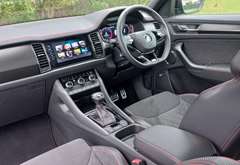The flagship of Skoda’s Kodiaq SUV range has had a heart transplant.David Thomson finds out if life has been added to the patient.
What’s new?
Skoda has ditched diesel in favour of petrol at the head of its Kodiaq SUV range, pensioning off the 176kW/ 500Nm 2.0-litre twin-turbo diesel that previously powered the flagship RS variant in favour of a 180kW/370Nm single turbo-petrol unit.
The new engine maintains the 2.0-litre, four-cylinder configuration of the outgoing motor, and it’s by no means a newcomer to the wider Volkswagen Group family of which Skoda is a part; among many other deployments, its engine is found in 180kW/ 370Nm guise powering the current VW Golf GTi and the latest Skoda Octavia RS.
This headline mechanical change comes as part of a wider mid-life refresh of the first generation Kodiaq, which also brings styling tweaks, interior revisions, and upgrades to the infotainment suite.
In its latest guise, the Kodiaq range comprises six different variants, of which the $74,990 Sportline TDI 147kW 4x4 is now the sole diesel on offer. The petrol line-up starts with a pair of front-drive 6-speed DSG 1.4-litre turbos, the $48,990 Ambition TSI 110kW and $57,990 Style TSI 110kW. The next steps up the family tree bring 2.0-litre turbo-power, a seven-speed DSG transmission and four-wheel-drive, for the $63,990 Style TSI 132kW and $69,990 Sportline TSI 132kW variants. The revised RS slots in above the turbo-diesel, with a $79,990 sticker.
Unusually, the flagship 180kW RS variant is more fuel-efficient than its less-powerful 132kW 2.0-litre petrol counterparts. Like the 110kW 1.4-litre Kodiaqs and the 147kW turbo-diesel, it rates as neutral under the Government’s clean car discount scheme, whereas the 132kW versions incur a $1093 fee.
This test focuses on the flagship RS or, to use its full name, the Kodiaq RS TSI 180kW 4x4.
What comes as standard?
The entry-level Ambition has an active safety suite, comprising front, side and lane assist technologies, autonomous city emergency braking, self-dipping headlights, cornering-function fog lights, front and rear parking sensors, and a rearview camera. Moving up to Style specification and beyond adds adaptive radar cruise control, traffic jam and parking assist, a 360-degree view camera suite, and tyre pressure monitoring system.
The infotainment suite centres on an 8-inch touchscreen for the Ambition, and a 9.2-inch screen on other variants. Wireless smartphone mirroring is provided on all variants, a premium 9-speaker sound system appears at Style level, and a fully digital main instrument cluster on the Sportline and RS. Skoda has gone with USB-C plugs, but the only two plug points are in the front of the cabin.
A power-operated tailgate features across the range, with a gesture control opening function at Style specification and above. Adaptive chassis control also presents beyond base-level, in conjunction with a special offroad mode for four-wheel-drive variants, and there’s a change up from 18-inch to 19-inch alloys for the Style and Sportline, and to 20-inch wheels for the RS.
Further key features for the Ambition include heated mirrors, a heated multifunction steering wheel, wireless phone charging, and dual zone climate control. Three-zone climate control is introduced at Style level, along with leather upholstery, heated and power-adjusting front seats, and LED interior lighting. The Sportline and RS add heated rear seats, front sports seats, paddle shift controls, and premium leather trim. The test car also featured a panorama sunroof.
As a point of difference, the Kodiaq is one of very few vehicles other than a luxurious Rolls-Royce to come with an umbrella mounted in the driver’s door as a standard item. There is also a plastic ice-scraping tool mounted within the fuel flap.
What’s it look like?
Sharply chiselled styling lines have become such a common feature of car design that it’s easy to forget how fresh and original the Kodiaq was when it first appeared here in 2017. Disguising the considerable size of the vehicle quite well, the look remains quite contemporary five years on, which is why the visual update for 2022 has been mild.
Up front there are sleeker headlights, some subtle reshaping of the grille, and minor changes to the bumper. The tail gets a similarly low-key refresh, with changes to the lights and bumper.
The RS stands apart with its 235/45-shod 20-inch alloys, gloss-black sports grille, and vRS badging front and rear. Like the Sportline, it takes Matrix LED headlights, black roof rails and mirrors, and additional underbody protection.
What’s it like inside?
The core cabin architecture has not changed, with the RS — like all Kodiaq variants — configured as a seven-seater.
Boot capacity is a decent 270-litres when both third-row seats are raised. The rear seats are definitely for kids, being tight for room and a scramble to access. They fold down into the boot separately via an easy-release system, and in this configuration the vehicle provides a 765-litre luggage capacity. This storage capacity rises to over 2,000-litres when the middle seats are folded down too.
The boot includes an underfloor storage space for the cargo blind, side-mounted storage bins, bag hooks, and adjustable cargo spacers that prevent smaller items from moving around.
Split 40-20-40, the middle seats offer considerable flexibility, including both fore-aft and back angle adjustment. Generous in respect of head and legroom, the middle seats are set fairly high, and so provide good visibility. A separate temperature control, sunshades, and outboard seat heaters are all welcome features, but Skoda has missed a trick by not providing any USB plug points for occupants in the middle or back seats.
Up front soft-touch surfaces predominate, and the seats are attractively trimmed with conventional leather bolsters and perforated suede cushions. This styling plus the extensive use of red contrast stitching, and red-accented vRS badging on the seats, the gear lever and the steering wheel give quite a lift to the cabin area.
Interior fit and finish is first rate, with thoughtful features like felt-lined door pockets, and reversible inserts just forward of the centre bin that can serve as a dual cupholder or an oddments tray. The wireless charging tray at the base is a snug fit for larger mobile devices, which can be a fiddle to remove when the gearshift is in park.
The front seats are supportive and very comfortable, and the layout of key controls and instruments is clear and logical. While Skoda has adopted elements of VW’s latest ICT interface with the upgrade, it has not gone for the time minimalist approach of button-elimination on a grand scale. So, while the centre touchscreen handles many key functions, there is a conventional array of buttons and knobs below for the climate control system, along with a cluster of drive-related switches around the gearshift.
The home screen layout of the centre display uses a series of tiles to access key functions, and while this is by no means the largest screen in its class, the displays are clear, and usability is good. The main instrument cluster is also fuss-free, and being fully digital, it can be configured several different ways.
What’s it like to drive?
In switching from turbodiesel to turbo-petrol power for the flagship Kodiaq RS, Skoda has traded away an easy-going muscular performance for sportier top-end vibe. Having been a big fan of the former, I was apprehensive about the change, and on balance still feel that the powerful low to mid-range punch that turbodiesel power delivers is optimally suited to reasonably large SUVs like the Kodiaq.
That reservation expressed, there is merit in the turbo-petrol approach: with maximum torque produced from just 1600rpm there is still solid low-to-mid-range thrust, and a more mechanically engaging (if busier) top-end.
Except in eco or comfort mode, the exhaust note is artificially enhanced within the cabin, though curiously, to produce a discordant five-cylinder-like burble emitting from a four-cylinder mill. Given that it’s already a well-proven combination elsewhere, it comes as no surprise that the 180kW/370Nm engine works smoothly in combination with the paddle-shift equipped 7-speed DSG transmission. A 0-100kph time of 6.6 secs for the new Kodiaq RS gives an interesting point of comparison with its predecessor, which cranked out the same sprint in 7.0 sec.
Select its sportiest drive modes, and the Kodiaq RS is more dynamically accomplished than other like-sized and like-priced SUVs. As well as unleashing full mechanical vim, these modes stiffen up the suspension and add heft to the steering. As a result, while a vehicle of this size could never claim to be nimble, it is nicely balanced, vice-free, and pleasingly agile.
Dialling back the intensity a notch, normal mode is ideal for typical lower South Island highway work, and comfort mode is a fine option for more refined motoring on major highways and in town.
Effortless is the term that springs to mind when describing the way the Kodiaq RS dispatches everyday motoring duties. Ride quality is very good in either comfort or normal mode, and even on coarse-chip seal, type roar is well contained at open road speeds.
A special offroad setting is provided, but while this optimises power delivery and the like for unsealed and potentially soft or lumpy surfaces, the Kodiaq RS is not a serious offroad machine.
While the 8.3/100km standard cycle fuel consumption figure and accompanying ‘‘neutral’’ rating under the clean car discount scheme are impressive for a seven-seater petrol-powered SUV range, there are caveats. Firstly, the Kodiaq RS requires a diet of 95 octane fuel. Secondly, unless gentle motoring with a significant highway component is your typical lot, that standard cycle figure is unlikely to be achieved in day-to-day life; by way of example, Drivesouth’s return over six days was 9.6l/100km.
- David Thomson
